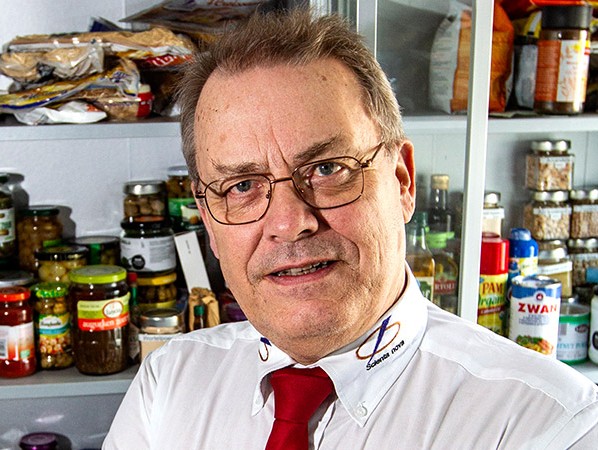
IJsbrand Velzeboer is a food technologist and owner of Scienta nova, an independent consultancy firm that deals with the most diverse topics within the food industry. Core tasks: advice, training, shelf life extension and risk assessment.
The four work areas (advice, training, research and inspections) of Scienta nova complement each other well. IJsbrand: “The experiences we gain during the inspections of companies and institutions provide great teaching materials, which we of course anonymise. It increases our progressive insight in the field of food safety and the associated regulations”. The food technologist wrote several books; fun and casually written, full of anecdotes from the professional field. His new book, ‘De witte leugens op mijn bord’, will appear later this year. It uncovers the hidden calculation and smuggling tricks on labels of products that can hardly be called honest. Meanwhile, in his countless blogs, he also provides food for thought to both consumers and the food industry, not only with iconoclastic statements, but by offering solutions as well. Time for a chat about one of the hottest topics of our time: food safety. Every week, we are startled by recall campaigns due to allergens not being indicated and possible contaminations of food with Listeria or Salmonella, glyphosate in beer...
“No, actually it is very good, partly due to the mandatory audits and inspections. It is unfortunate that all those audits take so much time. It should be possible to have an auditor come by every day without having to worry. Things should simply always be in order. Unfortunately, many companies are fully stressed out by it.”
“Because there is too much focus on ‘correct paperwork’. Auditors in BRC or IFS audits are increasingly looking for silly details; has everything been worded properly? I am completely fed up with that nit-picking behaviour. We have even seen an auditor discuss the mesh size of the hairnet during a food safety analysis audit. There is nothing in the law about this. Inspecting it has no place in an audit. Fortunately, the actual process is being looked at better and better, or the work floor understands what it is about. I do have my doubts about the way this is checked. Suppose an unknown auditor comes onto the work floor and starts questioning an autistic person at a filling machine. That man knows exactly what he’s doing and why, but shuts down completely. It results in a negative note. What exactly does that say about food safety?”
“What I support most is ISO 22000 with FSSC 22.000 below, a self-designed management system that forces the organisation to take all aspects into account: from management, risk analyses, education and further training to complaints and complaint handling and even the cleaning schedule; everything has to be in order. And go ahead and prove, with microbiological research and hard figures, that the machines and production rooms are clean and that you work in a food-safe manner.”
“‘Product-foreign parts’ are much less common now, although they are still high in the complaints top 10. Years ago, finding mice in milk bottles was the order of the day, but you don’t hear much about that now. Effective measures have been taken. For instance, everything is transported under cover and advanced machines detect even the smallest product-foreign parts. The increased food safety also results from greatly improved cause analyses.”

“The contradictory thing is: we know more, but also less. Consumers are much further removed from their food than our grandmothers used to be. They knew exactly what meat was used to make minced meat and that it is supposed to look dull. Consumers today are hardly bothered by knowledge of food. Who knows how it is made, what exactly is in it, and where the ingredients come from? Only those who are told to watch out by their general practitioner due to a disease, or a food allergy or intolerance, read the label and are aware of what they are eating. But do not underestimate the power of consumers! Quality awareness is growing. And I like contributing to that. Consumers have the right to know what is in the products. Why is there so much water in minced meat and chicken breasts? Meat shrinks in the pan like a cheap shirt! I think that is a bad thing. I think the food industry can and should provide more quality and be more honest in their labelling.”
“Yes, that damn allergen risk. The NVWA is all over it and AH even has its own department for it. It often concerns tiny errors; ‘peanut’ not being translated correctly, or a couscous packaging that does not state that it contains wheat. I certainly don’t want to downplay the allergen story, but I do think there is a lot of exaggeration. Couscous is made of wheat, so of course there is wheat in it. What I do find very serious are glass or metal splinters in the product. I say: recall those, immediately! You can’t be strict enough when it comes to that. The standard for plastic, hard parts and metal is 7 mm for adults and 2 mm for children under 3 years old, but I would even consider a 1 mm splinter a disaster; the limit should absolutely be 0.”
“Palm oil is a topical theme, and especially ‘palm oil-free’, because it is better for the environment. Manufacturers use the cheapest oil and try to disguise that. It is indicated on a label in very small print, but you have to turn the packaging around to see it. Stop misleading consumers like that! Incidentally, palm oil isn’t even that bad. What I find terrible is finding very odd chemical substances when analysing products: 3-MCPD esters. Odd things happen somewhere in the refining process, so that chlorine compounds maybe left behind.”
“The long-term use of the same chemical disinfectants, such as hypochlorite and quads (quaternary ammonium compounds), also form a great risk. I find that worrying. The first resistant listeria strains have already been discovered. Only with thermal disinfection, with the right heating, can you break the resistance cycle. Perhaps phages are a solution, we are currently looking into that.”
“A heatwave like that of last summer not only affects the harvests. It demonstrates how vulnerable our food system is. Now it is only about smaller apples or shorter fries, but the expectation is that this will occur more often. Another example: peanuts are traditionally dried in open air in Nigeria before being shipped. However, the rain season appears to start sooner and sooner, meaning the peanuts are wet before they arrive in the harbour. That creates a mould risk. Monocultures, such as olives and bananas, are vulnerable and sensitive to disease, drought or changing temperatures. When harvests become smaller, prices rise. But it also opens the door for fraud. Lots of olive oil is being tampered with. What matters is this: to what extent have such situations been included in companies’ current risk analyses?”

“A good Root Cause Analysis (RCA) is essential here. This method stimulates the chain-wide search for causes and avoiding repetition, by helping you objectively investigate a complaint, quality problem or incident. The great thing is that RCA is not focused on the question of blame, but on improvement. Every QA manager should be able to do this. RCA also forces to you properly assess your suppliers, because if you cannot control them, you are playing Russian Roulette. It is a fact: in many countries, food safety and certificates are really treated differently. Because of all that dragging of food around the world, many transport movements remain hidden. They increase the risk of contamination and fraud.”
“The public is currently being shook by messages about glyphosate in beer; is that food-safe? They see yellow fields cause by this miracle herb, and the farmer gets the blame. People don’t realise that it is also a chain problem. The farmer looks for a cheaper method of controlling weeds, because the prices they receive for their crops are outrageously low. And if you get that little for your products, you have to cut back on something. Deep ploughing costs a lot of fuel, so the cheaper solution is chosen: glyphosate.”
“The food industry also needs to get a higher margin, so that they can improve their research and development and continue working on improving food safety. The reasonableness in supermarket purchasing contracts is often hard to find, and I am sometimes baffled when I read them. Take the ‘Raw materials prices clause’: when oil prices rise, the manufacturer has to wait three months before they can pass on the price increase. With a price reduction, they are required to pass it on almost immediately. That is why there are all sorts of cuts in the industry as well, for instance choosing cheaper glass jars instead of slightly more expensive, so better quality, glass. The fact is that the risk of a cheap glass jar breaking is greater. Try expressing that in figures. There are also cuts on internal training and guidance: as a result, people who work production lines are less aware of what they are doing. That can have far-reaching consequences.”
“That’s right. The QA manager of today has to be broadly educated: they need to know everything about hygiene, disinfection and contamination, about legislation and micro-organisms, but also about the risks when a raw material is no longer available due to war, climate change or a mould. It used to be enough to just manage the process from the entry gate to the exit gate. These days, you need to know exactly where your raw materials come from, how they were transported and stored, how they were packaged on the way and what the humidity was; they are all determining factors for the food safety and shelf life of your end product.”
Photos: © Foto Hissink
Source: © Vakblad Voedingsindustrie 2019